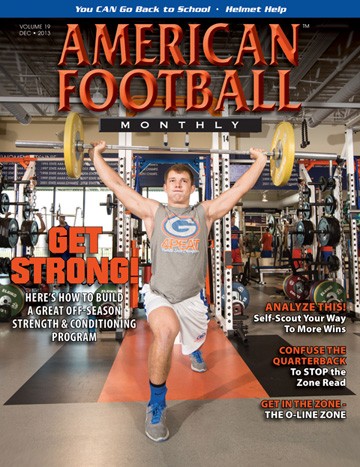Safety First: Time to Recondition
by: AFM Editorial Staff©
More from this issue
When your season ends, many pieces of equipment can simply be cleaned, inventoried and stowed away until they’re needed next summer. Not so with helmets.
Considering the pounding they likely have taken during the season and their critical importance from a safety standpoint, it is imperative that every helmet be inspected and either reconditioned or replaced if necessary. To learn more about reconditioning and coaches’ role in the process, AFM spoke to Ed Fisher, executive director of the National Athletic Equipment Reconditioners Association (NAERA).
NAERA is made up of 21 companies that recondition and recertify approximately 1.7 million football helmets each year. Each company is licensed by the National Operations Committee on Standards for Athletic Equipment (NOCSAE) to recondition and recertify helmets manufactured under the NOCSAE logo. Helmets that are reconditioned and recertified in a NAERA facility are returned to the school or owner, meeting the original helmet manufacturers’ specifications.
Xenith X2 helmets are reconditioned at the company’s facility in Massachusetts.
Reconditioning is the inspection, cleaning, sanitizing, repair and restoration of athletic equipment to the original performance standard. Recertification is the reconditioning, testing and proper labeling of athletic equipment that has previously met the NOCSAE standard and recertification standard.
According to Fisher, it is recommended by NAERA and NOCSAE that each helmet be reconditioned and recertified each year, or at a minimum every other year. “One football helmet manufacturer requires their helmets be reconditioned and recertified each year to maintain the warranty,” according to Fisher. “Other helmet manufacturers recommend each year but require at least every other year to maintain the warranty on the helmet.”
Here are Fisher’s responses to frequently asked questions related to helmet reconditioning:
AFM: Why is it important for coaches and/or equipment managers to inspect every helmet after the season is over?
Fisher: The number one reason for checking the helmet is player safety. The second reason is liability. A third reason is to determine the number of new helmets needed to be purchased after reconditioning/recertification.
What should coaches or equipment managers look for when inspecting helmets?
Coaches and equipment managers should be looking and checking for proper fit of the helmet on the athlete during the season on a weekly basis. After the season, helmets should be sent to an NAERA member for reconditioning and recertification. A preliminary check by coaches and equipment managers should include but not limited to: cracks in the helmet, any damage to the internal parts, extensive gouging in the shell, proper hardware for facemask and chinstraps, exposed metal on the facemask, and proper seals on valves.
How is it decided when a helmet should be replaced instead of being reconditioned?
The life of a football helmet varies greatly. Helmets of players that are in high contact positions, like linebackers and offensive and defensive linemen, may be different than players that are not involved in as much contact such as wide receivers, quarterbacks, and kickers. A trained NAERA member representative should inspect all helmets.
What is involved in the reconditioning process?
At the beginning of the reconditioning/recertification process, a statistically relevant number of helmets are identified for the NOCSAE drop test both pre- and post-reconditioning. All helmets are sent through a process that includes removal of the facemask and all external stickers/labels. Helmets are disassembled and parts are washed, cleaned, sanitized, dried and checked for any defects. The shell is buffed, washed and prepped for painting. Helmets are reassembled to the manufacturers’ specification and new hardware is put on. All labels are replaced on the inside and outside of the helmet stating that the helmet meets all manufacturers and NOCSAE standards.
Are reconditioned helmets as safe as new helmets?
Yes, all helmets that are reconditioned and recertified in a NAERA facility meet manufacturers’ and NOCSAE standards the same as new helmets.
What is the anticipated lifespan of a helmet? Does reconditioning add to that expected lifespan?
The simple answer is ‘yes’, reconditioning can maximize the life of the football helmet. A non-reconditioned/recertified helmet involved in a player injury can lead to personal and institution liability for the equipment manager/coach/school administration as well as the school district. NAERA members will not recondition/recertify any helmet 10 years old or older.
What is the approximate cost of reconditioning compared to a new helmet purchase?
The cost to recondition varies greatly. Some parts cost upward of $60 for one part. But generally, a football helmet can be reconditioned for $40 – 45 dollars for an adult helmet and $25 - $30 for a youth helmet. Painting of helmets during the reconditioning process can cost extra. The cost of a new youth helmet can be between $80 and $130. The cost of a new adult helmet can be between $200 and $350. p
Ed Fisher has been the executive director of NAERA since 2005. From 1997-2004 he was a high school administrator at North Central High School in Spokane (WA). Fisher was previously the head football coach at South Kitsap High School in Port Orchard (WA) from 1974-1996. He also coached at Klamath Union High School (OR) and was a graduate assistant at the University of Hawaii.





